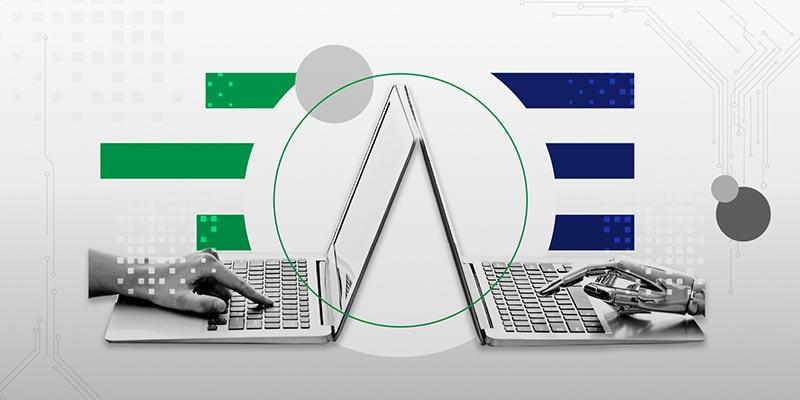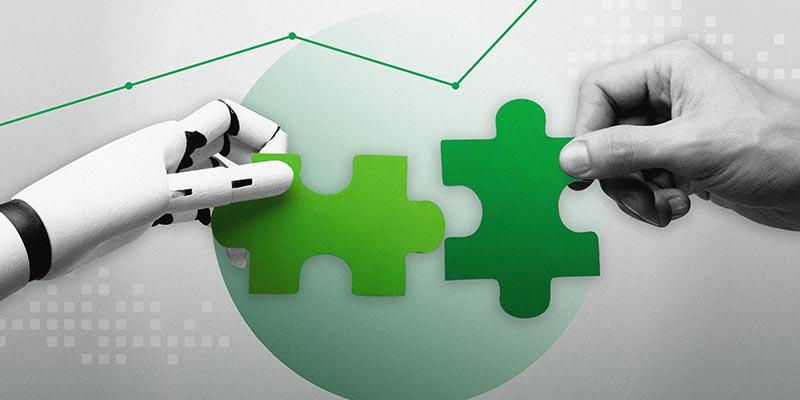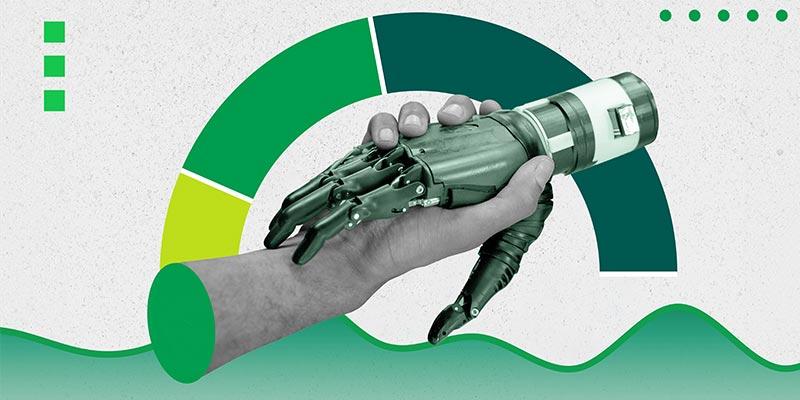Corporate investment in AI technologies is booming. Global spending on AI is projected to reach approximately $632 billion by 2028.1
In addition to AI, companies are investing heavily in new digital technologies. According to The Bureau of Economic Analysis, the new digital economy accounts for 9% of the U.S. GDP.2
Workplaces Are Not Prepared for AI
The rapid adoption of AI tools for business and other digital technologies is having a profound impact on organizations and their employees as nondigital processes and ways of working are fundamentally transformed.
This workplace revolution has resulted in a gap between the rapid availability of artificial intelligence tools and the extent to which employees are using them.
Employees are broadly optimistic about AI’s potential -- two-thirds believe AI will have a somewhat (52%) or extremely (14%) positive impact on their work. However, nearly seven in 10 employees never use AI at all, and only one in 10 use AI applications at least weekly.
One reason for this usage gap is that employees do not feel well-informed about their organization’s plans to implement AI or feel they haven’t received sufficient AI training. Only 15% of U.S. employees strongly agree that their organization has communicated a clear AI strategy. Relatively few employees (11%) feel “very prepared” to work with AI and related digital technologies in their role -- down six percentage points from Gallup’s 2023 finding (17%).
Among U.S. employees who say their organization has communicated a clear strategy for integrating AI into its business, 87% indicate they believe AI will have an extremely positive impact on their productivity and efficiency.
Is Your Culture AI-Ready?
How can leaders bridge the AI usage gap and ensure success with their organization’s AI-led digital transformation? A recent study found that only about one in five digital transformation initiatives achieve their growth or efficiency goals.3
A common factor in many of these failures is organizational culture. Eliminating uncertainty and helping employees embrace AI and its vast potential require organizations to prioritize the cultural component of AI adoption and digital transformation.
Establishing a culture that fosters new ways of working and encourages the adoption of new technologies that deliver value to the organization -- and ensuring employees feel a strong connection to that culture -- is essential.
Leaders need to consider and address three key dimensions of organizational readiness that are essential to building a culture that prepares employees to make the most of AI and other digital technologies.
Strategy:
- Is there a clear vision for how AI will help the organization achieve its goals?
- Is your workforce optimistic about the impact of AI on individual, team and organizational performance?
- Do you have the necessary organizational agility to adapt your vision as the organization increases its deployment of AI tools and applications?
Leaders need to build and communicate a well-articulated AI strategy with specific goals and provide clear direction and alignment on the optimal use of resources to deliver the strategy efficiently.
Skills:
- Do your employees know how to use AI and AI tools?
- Have you implemented a robust learning strategy to ensure that the organization continually tests, adapts and evolves your vision for AI technologies and their deployment?
- Have you created an effective feedback loop for testing and learning as AI adoption grows throughout the organization?
Nearly half (47%) of employees who use AI say their organization has not offered them any training on how to use AI in their job. Leaders must bridge the AI skills gap to alleviate employee frustration and resistance to AI adoption.
Security:
- Do all employees understand your organization’s AI policies and guidelines?
- Have you anticipated and planned for potential limits and barriers to AI adoption?
- What assumptions have your organization’s security measures been based on?
- Are you merely trying to control AI -- or unleash its full potential for the organization?
Addressing the above will reinforce employee confidence in the organization’s implementation of AI technology, provide clear guidance on how AI should be used, and substantially reduce risks associated with data privacy and protection issues.
A Human-Centered Approach to AI
To help leaders respond to the key dimensions of organizational readiness, Gallup has developed a human-centered framework for AI adoption and digital transformation with four essential elements:
- Diagnose culture. Leaders should approach the integration of AI technologies by first assessing their organization’s cultural readiness. An effective qualitative and quantitative cultural assessment will provide critical insights to leaders and inform the organization’s AI vision and strategic roadmap.
- Align investment with purpose. New technology investments should align with the organization’s purpose, or the why that underlies the investment.
For example, a company with a culture that emphasizes agile, collaborative decision-making, extreme innovation or exceptional customer service should invest in AI technologies and applications that help it do these things more effectively and reinforce its competitive differentiation. Aligning decisions about AI deployment and investment across functions and departments with things that create the greatest value for customers or fulfill the organization’s purpose is crucial.
- Communicate a clear AI narrative. For employees, adopting new ways of working requires a compelling rational and emotional case to help them understand what will change and what will stay the same. AI is more than just a rational business investment in the organization’s future; it should also inspire hearts and minds.
Leaders must create a credible, engaging narrative for AI implementation that addresses employee concerns and fosters buy-in, energy and engagement. When employees strongly agree that leaders have communicated a clear plan for AI implementation, they are 2.9 times as likely to feel very prepared to work with AI and 4.7 times as likely to feel comfortable using AI in their role.
The plan should include clear guidelines that define how and where AI tools will be applied and empower employees to experiment with AI to do their jobs differently and better. It should also address the need for role-specific training so that employees can harness the full potential of the AI tools at their disposal.
- Sustain adoption. New technology adoption will fail if leaders don’t foster and replicate the right cultural behaviors. Initial enthusiasm for AI must turn into habits. Barriers to new ways of working will inevitably arise if leaders and employees do not identify, communicate and overcome them. Leaders must celebrate and reinforce success stories and best practices on an ongoing basis to maintain AI’s potential to transform the workplace.
Prepare Your Culture for the AI Revolution
AI has the potential to improve employee productivity, power innovation and increase efficiency. When deployed in an organizational culture that fosters adoption of innovative technologies, AI can help teams work more efficiently, drive growth and reduce costs. Ultimately, AI can liberate people from onerous tasks so they can spend more of their precious time on high-value work that humans do best.
There are no signs of a slowdown in corporate investment in AI and other digital technologies. The AI revolution is here -- and it is up to leaders to ensure their organizations and people are ready to make the most of it.
Create a culture that supports the AI journey for your employees.
- Discover more about using culture as a competitive advantage.
- Develop a robust and unique AI strategy with Gallup’s AI consulting expertise.




